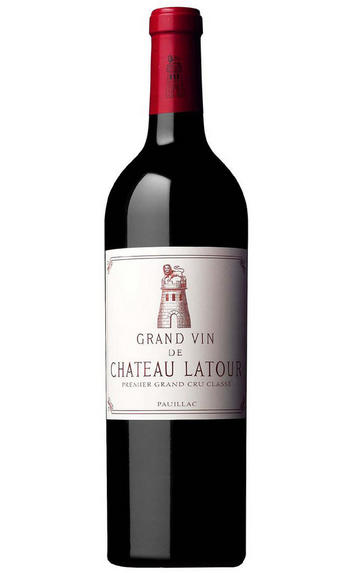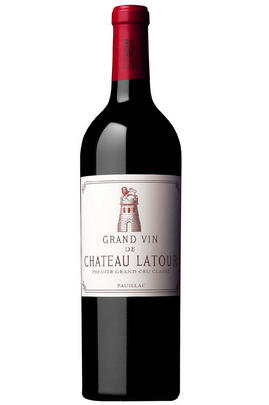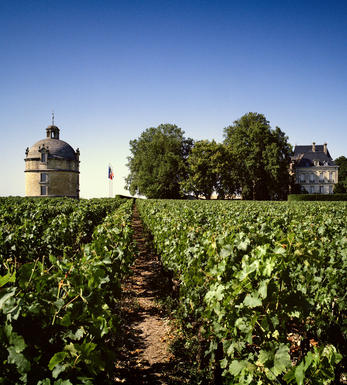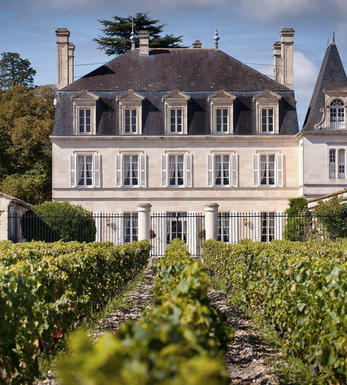
2003 Château Latour, Pauillac, Bordeaux

Critics reviews
The 2003 Latour is a wine that I have tasted many times, even buying some en primeur. Now it is reaching 20 years, and like other 2003s, I am beginning to think that even the best wines in the early days are starting to fall short of expectations. That is not to say it is a bad wine by any means. With layers of black fruit on the nose and hints of cedar, white pepper and aniseed, it is pretty burly aromatically and opens nicely with 20-30 minutes in the glass.
The palate is structured and assertive, with grippy tannins and plenty of tobacco-infused black fruit. However, compared to other vintages, there is something just a bit "static" about this First Growth, an immovable object. Moreover, the longer I remain in its presence, it seems a little removed from a typical Latour as if the imprimatur of the growing season is beginning to influence the wine more than the terroir. I've scored this wine high in the past, but it's a complex wine to really love at the moment.
Drink 2024 - 2050
Neal Martin, Vinous.com (August 2023)
There were only 10,800 cases made (rather than the normal 15,000-20,000).
2003 was one of the hottest, earliest Bordeaux vintages ever. Some vines suffered from lack of moisture, but old vines and clay subsoil at Enclos saw this vineyard through. The Merlot harvest occurred between September 8 and 13, and the Cabernet Sauvignon was picked between September 22 and 30.
The 2003 Latour is a blend of 81% Cabernet Sauvignon, 18% Merlot and 1% Petit Verdot. Six percent of the press wine was added to the final blend. It has a medium to deep garnet-purple color, then wowit explodes from the glass with bombastic black and blue fruits, followed up by meat, wood smoke, sandalwood and Indian spice accents with underlying floral wafts. The palate is full, rich, velvety, seductive and very long on the finish.
Lisa Perrotti-Brown, Wine Advocate (February 2019)
Magnum. Magisterial! Immediately profound on the nose, delivering rock-solid classic Bordeaux. So lengthy, so refined. A rich tapestry of flavours from the darkest fruits to the most lifted fragrance. And so lengthy! Truly worth the accolades, and who knew 2003 would turn out so well?
Drink 2018 - 2033
Richard Hemming MW, JancisRobinson.com (May 2022)
Administrator Frederic Engerer says the 2003 is “the sexiest Latour ever made.” He also described it as “the 1990 without any brettanomyces.” I loved this wine from the barrel and was fortunate enough to be able to purchase a small quantity, enjoying every bottle I have had. A profound example of Chateau Latour, the full-bodied, opulent 2003 is already performing well at age eleven, which is somewhat atypical. The pH is a relatively high 3.8, which also indicates low acidity.
The wine is very ripe, but not over-ripe, offers great freshness, and lots of creme de cassis and camphor as well as hints of blackberries and chocolate. Dense, thick and unctuously textured, this staggering Latour is undeniably the most sumptuous, opulent wine made here since the 1982 or 1961.
Drink 2014 - 2034
Robert M. Parker, Jr., Wine Advocate (August 2014)
A very flamboyant and exciting Latour. Sliced black truffles, sweet leather, spices, and dark fruits on the nose. Full and powerful, with roasted fruit and leather undertones. Big and velvety, with polished, almost dusty tannins, and a super long finish. This leans more towards sexy than intellectual. Very concentrated.
James Suckling, JamesSuckling.com (February 2011)
Red-ruby. Explosive aromas of plum liqueur, currant, minerals and lead pencil. Huge, lush, sweet and utterly seamless; this has the palate-caressing texture of liquid velvet. About as deep as this extreme vintage gets. Finishes with noble, compellingly sweet tannins and great length. This is an amazing wine, and only its exotic character prevented me from giving it an even higher score. Interestingly, the IPT here is 65, compared to 67 for the 2005. But this voluminous and powerful wine will be more fun to drink than the 2005 for many years simply due to its sensual appeal, even if the 2005 should ultimately surpass it in verve, minerality and overall aromatic complexity.
Incidentally, Latour's third wine, simply called Pauillac, is extremely good in both 2005 and 2003-the former vintage showing terrific energy and loads of early personality, and the latter fat, round and exotic, with what Engerer described as a "Napa nose."
Stephen Tanzer, Vinous.com (May 2006)
About this WINE

Château Latour
Château Latour is a wine estate in Pauillac, part of the Haut-Medoc sub-region on the Left Bank of Bordeaux. The estate’s history dates back to at least the 14th century, though vineyards were not established here until the 17th century. The estate is located at the southern edge of the Pauillac appellation, bordering the St Julien vineyards of Château Léoville Las Cases. Latour is one of the five First Growths of the 1855 classification, occupying the top tier alongside Châteaux Lafite Rothschild, Margaux, Haut-Brion, and Mouton Rothschild.
Latour is owned by François Pinault, one of France’s wealthiest people. It forms the jewel in the crown of Pinault’s Artémis Domaines, itself part of the larger Groupe Artémis. Other wineries within the portfolio include Clos de Tart and Domaine d’Eugénie in Burgundy; Château Grillet in the Rhône Valley; Champagne Jacquesson; Eisele Vineyard in California’s Napa Valley; and Maisons et Domaines Henriot, which includes holdings in Champagne, Burgundy, and Oregon.
The day-to-day running of Latour is entrusted to the dynamic Frédéric Engerer. Under his stewardship, a major programme of investment has taken place. In 2012, Latour announced that it would no longer offer its wines as part of the Bordeaux En Primeur campaign. Instead, the wines are kept at the estate until such a time as they are ready to be opened and enjoyed. They are then offered through the La Place de Bordeaux distribution system several years after the vintage.
There are three wines produced here. Château Latour, the grand vin, is produced from vines immediately surrounding the château, from the vineyard area known as L’Enclos. Les Forts de Latour, the second wine, was created in 1966. It is now regarded as a great wine in its own right, certainly worthy of Classified Growth status. A third wine, Pauillac de Latour, is usually the product of young vines.
The vineyard is planted to a majority of Cabernet Sauvignon, along with some Merlot and small amounts of Cabernet Franc and Petit Verdot.

Pauillac
Pauillac is the aristocrat of the Médoc boasting boasting 75 percent of the region’s First Growths and with Grand Cru Classés representing 84 percent of Pauillac's production.
For a small town, surrounded by so many familiar and regal names, Pauillac imparts a slightly seedy impression. There are no grand hotels or restaurants – with the honourable exception of the establishments owned by Jean-Michel Cazes – rather a small port and yacht harbour, and a dominant petrochemical plant.
Yet outside the town, , there is arguably the greatest concentration of fabulous vineyards throughout all Bordeaux, including three of the five First Growths. Bordering St Estèphe to the north and St Julien to the south, Pauillac has fine, deep gravel soils with important iron and marl deposits, and a subtle, softly-rolling landscape, cut by a series of small streams running into the Gironde. The vineyards are located on two gravel-rich plateaux, one to the northwest of the town of Pauillac and the other to the south, with the vines reaching a greater depth than anywhere else in the Médoc.
Pauillac's first growths each have their own unique characteristics; Lafite Rothschild, tucked in the northern part of Pauillac on the St Estèphe border, produces Pauillac's most aromatically complex and subtly-flavoured wine. Mouton Rothschild's vineyards lie on a well-drained gravel ridge and - with its high percentage of Cabernet Sauvignon - can produce (in its best years) Pauillac's most decadently rich, fleshy and exotic wine.
Latour, arguably Bordeaux's most consistent First Growth, is located in southern Pauillac next to St Julien. Its soil is gravel-rich with superb drainage, and Latour's vines penetrate as far as five metres into the soil. It produces perhaps the most long-lived wines of the Médoc.
Recommended Châteaux
Ch. Lafite-Rothschild, Ch. Latour, Ch. Mouton-Rothschild, Ch. Pichon-Longueville Baron, Ch. Pichon Longueville Comtesse de Lalande, Ch. Lynch-Bages, Ch. Grand-Puy-Lacoste, Ch, Pontet-Canet, Les Forts de Latour, Ch. Haut-Batailley, Ch. Batailley, Ch. Haut-Bages Libéral.

Cabernet Sauvignon Blend
Cabernet Sauvignon lends itself particularly well in blends with Merlot. This is actually the archetypal Bordeaux blend, though in different proportions in the sub-regions and sometimes topped up with Cabernet Franc, Malbec, and Petit Verdot.
In the Médoc and Graves the percentage of Cabernet Sauvignon in the blend can range from 95% (Mouton-Rothschild) to as low as 40%. It is particularly suited to the dry, warm, free- draining, gravel-rich soils and is responsible for the redolent cassis characteristics as well as the depth of colour, tannic structure and pronounced acidity of Médoc wines. However 100% Cabernet Sauvignon wines can be slightly hollow-tasting in the middle palate and Merlot with its generous, fleshy fruit flavours acts as a perfect foil by filling in this cavity.
In St-Emilion and Pomerol, the blends are Merlot dominated as Cabernet Sauvignon can struggle to ripen there - when it is included, it adds structure and body to the wine. Sassicaia is the most famous Bordeaux blend in Italy and has spawned many imitations, whereby the blend is now firmly established in the New World and particularly in California and Australia.


Buying options
Add to wishlist
Description
Initially I had my reservations about this controversial wine. Question marks have hovered above the vintage across Bordeaux since release, many Chateaux claiming their 2003s are great but atypical. Let me set the record straight, this 2003 Ch. Latour is more than great, and quintessential Latour. The nose is rich and pure Pauillac. In the mouth the ripeness really shines through. The wine builds and builds, the volume of flavour is outstanding but all kept in check by a beautiful structure. The wine is complete and now beautifully integrated with an endless finish. Of course, this icon will age almost indefinitely but has the balance to give some much pleasure now. If you love Latour, your cellar is not complete without this.
Berry Bros. & Rudd
wine at a glance
Delivery and quality guarantee